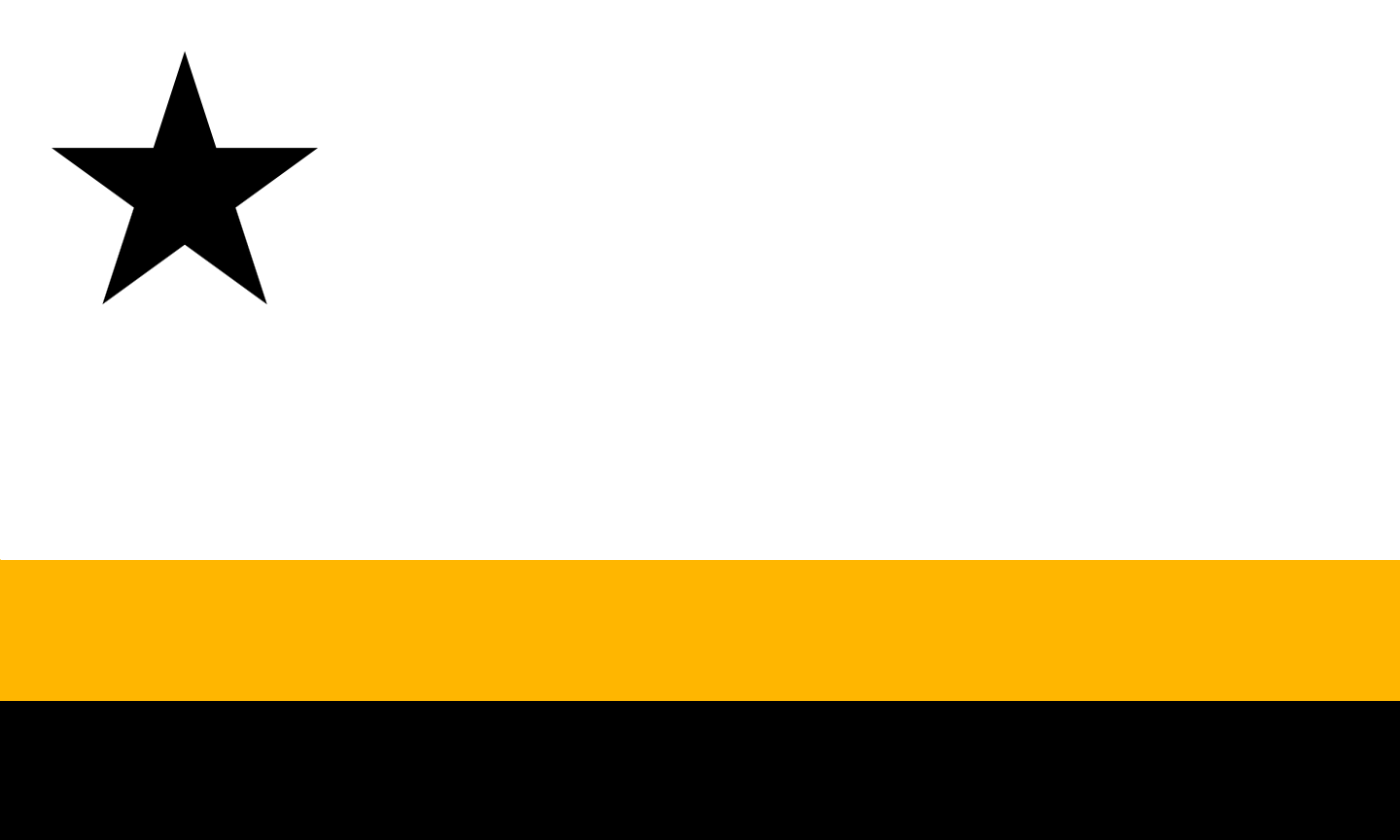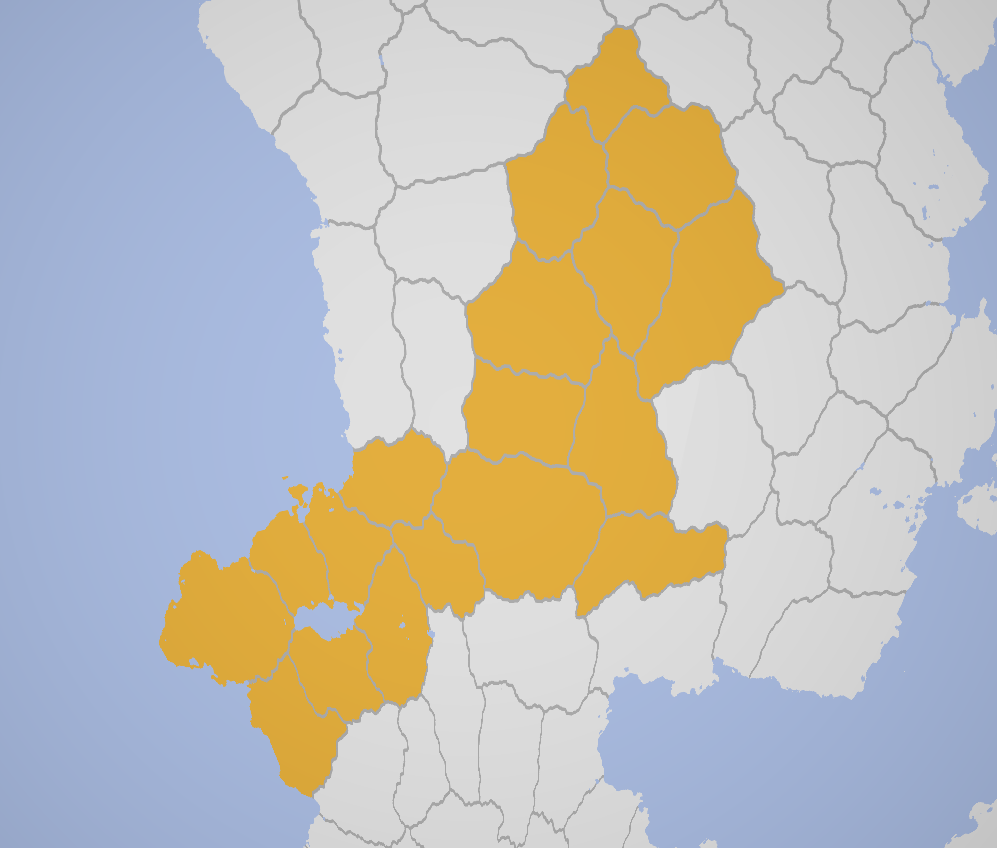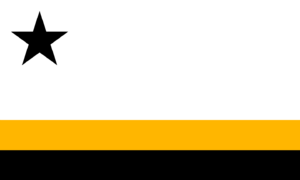Arvene
|
Arvenian Union
Arvenēa
|
|||||
|---|---|---|---|---|---|
 |
|||||
| The Flag of the Arvenian Union | |||||
| Common Name | Arvene | ||||
| Anthem | Arvene, Our Beautiful Land! | ||||
 |
|||||
| Demonym | Arvenians | ||||
| Official languages | Arvenian, Kalban | ||||
| Currency | Arvenian Korona | ||||
| Politics | |||||
| Capital | Stell | ||||
| Government | Unitary Presidential Republic | ||||
| Foundation | 2190 (Current Constitution )
2110 ( Foundation of the Federation ) 1958 ( Arvenian Republic ) |
||||
| President | Markus Klavan | ||||
| Preceded by | Federation of Arvene | ||||
| Demography | |||||
| Ethnicities | 63.1% Arvenian
28.9% Kalban 8% Ilishiran |
||||
| Population | 16 425 100 | ||||
Etymology
###
Geography
###
Climate
###
Biodiversity
Urban Areas
Politics
Government
The 120-Seat Arvenian National Assembly is elected by direct popular vote every four years. The president is elected by the National Assembly in a separate election, also held every four years. The president appoints a prime minister who, together with his cabinet, forms the executive branch of the government, which has to receive a confidence vote by the National Assembly. The most senior civil servants are the thirteen Secretaries of State.
Each Province gets 15 representatives in the There are a total of 120 members of Parliament.
Provinces
Following the dissolution of the Federation and the proclamation of the Union, and the ratification of the 2190 Constitution, the power has been given entirely to the Arvenian government,
with the provincial government's powers being severely limited, though they can still decide on some of their own matters. The City of Stell is run directly by the Arvenian government,
as it contains the capital of the nation.
Demographics
Culture
The Arvenian Culture is heavily oriented towards progress, owing to the early federal government supporting technological advancement and social
progress, funding schools and universities, providing them with new education methods, and supporting the development of new technologies.
However, Arvene also has a rich traditional culture, derived from the decades-old pre-Union cultures of the previous, failed states in the region from centuries ago. Additionally, much of modern Arvenian culture is heavily influenced by the neighboring states of Aterus and Fortis, and as such public feelings towards those nations is generally amicable.
Education
###
Age
###
Military
Arvenian Air Force
The Arvenian Air Force is one of the most funded branches of the Arvenian Self-Defence Force, only being surpassed by the Arvenian Union Army,
The AAF primarily uses aircraft of Zokseian and Crytilian origin, with the Z-201 and the Kaminari being the most used aircraft.
Arvenian Union Army
The Arvenian Union Army is the largest branch of the military, and consists of recruits who have volunteered to serve in the army and to protect their nation.
Infantry
The Arvenian Infantry are equipped with the lastest small arms and support equipment, to ensure their supremacy on the battlefield.
The Army's standard issue rifle as of 2200 is the Zokseian ZAR-6, which has been purchased in enormous quantities during the 2160s, and as a result of it, is still being issued to Arvenian infantry,
despite being over 40 years old as of now. In 2192, the Arvenian government has launched the ''SPXFRM'' program to develop a new modern rifle to replace the aging ZAR-6, though
due to budget cuts and various other issues, only a handful of the new FRM-1 rifles have been issued to the army.
Vehicles
The Arvenian Union Army possesses a quite large amount of ground vehicles, though their quality varies, as most of the vehicles used by the army
is are least 20 years old, and require constant maintenance to be kept in working order.
The most common tank used by the Arvenian Union Army is the PMT 4 Main Battle Tank, while the APC/IFV role is filled by the BTP-6, with several variants in service.
For light recon duties, the Arvenian army uses a variety of light vehicles, such as the ZA-2 Armored Car.
The Arvenian Union Navy
The Arvenian Union Navy is tasked with protection of the Arvenian territorial waters as well as S&R operations.
Their fleet is mostly comprised of Stell Class Destroyers, with the main pride of the fleet being the JL Cerimia, formerly the
SS Drekvak. The AUN also possesses 2 aircraft carriers, The JN Stell and JN Stepela, and there are plans to purchase other vessels in the future.
Economy
The economy of the Arvenian Union is quite strong, with a heavy emphasis on technology, manufacturing, and services. The national government invests regularly in what it considers breakthrough technologies, and subsidizes some industries needed to keep the country running smoothly. However, hand-in-hand with that, the Union's government is also strict with enforcement of its strong financial and economic regulations, meant to prevent corruption, financial crimes, and manipulation of the market for ill purposes from occurring. Tax evasion is something ill-advised to undertake in the Union.
History
Prior to 1958, the region of Kerbin that Arvene rested in was occupied by many different nations, while speaking the same language, they were disunited, and as such, they were an easy target for whoever decided to take their land for themselves.
However, in the early 50s, this began to change.
Foundation of the Arvenian Republic
In the early 1950s, four major groups rose to power in the region.
1.The Arvenian National Movement (ANM)
2. The People's Republic of Feliska (PSF)
3.The Arvenian Unity League (AUL)
4. The Raina Battalions (RB)
These four power blocks governed may cities and towns across what would become modern-day Arvene. However, over time, the leaders of the ANM, PSF, AUL and the RB came to see the existential risks to their respective peoples' welfare, and came together in 1958 to forge a constitution and declare an unified state, with an emphasis of not repeating the mistakes of the past, and securing a bright future for all. The first years of the Arvenian Republic were spent on unifying the nation and modernization of it.
However, following the early struggles of the nation, its economy boomed with proper exports and manufacturing being supported again, and with the forward-thinking, progressive bent of the nation's political scene, Arvene's populace boomed with immigration of scientists, academics, and intelligentsia from around the world.
The 2110 Crisis and the Federalization of Arvene
In 2109, a crisis hit Arvene, as due to recent negligence of the rising hyperinflation and various other economic issues, the Arvenian economy collapsed in a matter of days, which caused protests rocking the entire nation, with tens of thousands of Arvenians protesting against the government across Arvene. In response, the government decided to pacify the protestors by any means possible, which led to bloody street battles that lasted for over a month, which would be later infamously called the ''Bloody December'' by the people of Arvene. The protests culminated in the dissolution of Arvenian government in January 2110, and the formation of the Federal Coalition, a coalition of opposition activists, students, and other dissidents. On March 19th, 2110, the
new constitution was ratified, which reorganized Arvene into a federation of provinces, with the province's autonomy being significantly higher compared to what was before. A new national flag was also introduced to represent the people
and land of Arvene, and it was flown all across the nation as a sign of celebration of change and progress.
The Arvenian Membership in the Confederacy and The Kalban-Arvenian War
In the early 2150s, the Federation of Arvene started to establish diplomatic ties with Zokesia, as the current Prime Minister of Arvene, Orgen Federic, seen
Zokesia as the only possible superpower that Arvene could be align to on good terms, without being undermined. One of the most important steps in the Arvenian ascension to the Confederacy was the creation of the 26th ''Odeln'' Arvener SS Division, which helped
to warm up relations between the militaries of both nations.
Following the Treaty of Stell in 2157, the Federation of Arvene officially became a part of the Arcovii-Zokesia Confederacy, prospering thanks to Zokesian funding and other means of support, and in
exchange Arvene provided goods to Zokesia, creating a mutual positive relationship between the two countries.
During the 2150's the Federation of Arvene took part in the IU-NAM conflict, with cities on the west coast being subject to airstrikes from HCEE missiles.
Ferram island would also temporarily be handed over to the SFRK, warming up relations between the two nation for some time.
Aside from these issues, Arvene's situation seemed to be stable, with no signs of danger or decline anytime soon.
However, that would soon drastically change.
In 2167, the Treaty of Soltem would be signed, relinquishing Zokesian patronage to Arvene, leaving the nation weak for conquest by Aterus and the SFKR.
In response to the treaty, the current president, Ineke Karvenhaus, passed the 2168 Enabling Act, which granted all power to the president, because of a so called ''emergency situation''
currently going on. Widespread protests occured across the nation, but they were quickly pacified the Arvenian Police.
The Kalban-Arvenian War began on the morning of April 2 2168, when the Kalban government announced a ''special military operation'' to ''demilitarize'' Arvene. Minutes later, missiles and airstrikes hit across Arvene, including Stell, shortly followed by a large ground invasion along the Kalban-Arvene border. Karvenhaus declared martial law and a general mobilisation of all male Arvenian citizens between 18 and 50, who were banned from leaving the country.
At first, the SFKR forces overwhelmed the unprepared Arvenian military in the first days of the war, quickly capturing multiple cities and towns, and even being close to capturing the Arvenian capital, Stell.
However, the Arvenian armed forces, now reorganized and supplied with better equipment, pushed back the Kalbans back to the border, and soon they crossed into the SFRK, beating the undersupplied and tired Kalban
forces, capturing over half of SFRK territory before their surrender.
In the 2170 Treaty of Dolinia, the SFRK had to give up a 1/4 of their territory, and pay war reparations to Arvene, which resulted in massive protests across the NKR, eventually leading to their influence being significantly
diminished, with Arvene becoming the new regional power in Veiid for the next decade.
The Ilishiran Uprising and the Turmoil of the 2180's
Arvene, while being an regional power, still had it's fair share of problems, as the ANP-led Federal Government had stopped democratic elections from being held to ''ensure the stability of the nation'', as well as neglecting the Ilishiran
ethnic minority, which populated the southern provinces of Arvene.
In early October of 2182, after years of negligence, the Ilishirans revolted across cities and towns across southern Arvene, with citizen militias quickly capturing multiple cities and towns, with their biggest success
being the victory in the battle of Punkt, in which Ilishiran partisan forces defeated the 105th Arvenian Armored Division in a spectacular victory. Following the Ilishiran advacement across the south, the National
Salvation Council, which overthrew the federal government in a coup, proposed a truce, in which Arvene would hand over the Ilishiran-majority areas back to them.
Following the truce, the NSC, would hand over power to the Arvenian Transitional Government, created to oversee the transition of Arvene back into a democratic nation.
Soon, the ATG announced that the Federation of Arvene would cease to exist in it's current form on July 1st, 2190, and a new constitution would be introduced,
bringing democracy back to Arvene, and replacing the inefficient and clandestine bureaucratic federal system with a more stable and efficient one.
The Union Proclamation and Recent Events
On July 1st, 2190 the Federation of Arvene ceased to exist and in it's place, the Arvenian Union was created, with a new constitution in place, and a much more centralized, democratic government.
The new Arvenian government quickly introduced many social and economic reforms, which proved successful both in the short and long-term. However, the biggest change
were the first fair, free and democratic elections since 2164, with the Social Democratic Union ( SDU), a Pro-Zokesian, social democratic party, winning the 2190 elections, with them winning both the 2194 and 2198 elections thanks to their popularity
amongst the Arvenian population. Recently, their dominance has been challenged by the Arvenian National Conservative Association, composed of conservatives, federalists and various other conservative groups.
Recently, after re-establishing diplomatic ties with Zokesia and warming up the relations between the two nations, Arvene is scheduled to rejoin the Confederacy in July 2200, after over 3 decades of absence, with the
population having mixed feelings about it. While the younger generations are relatively positive about Arvene rejoining the Confederacy, the older generations have protested the reintroduction into the Confderacy,
bringing up the 2167 Treaty of Soltem, arguing that Zokesia will betray Arvene yet again.
Notable Events
###
About The Flag
###
